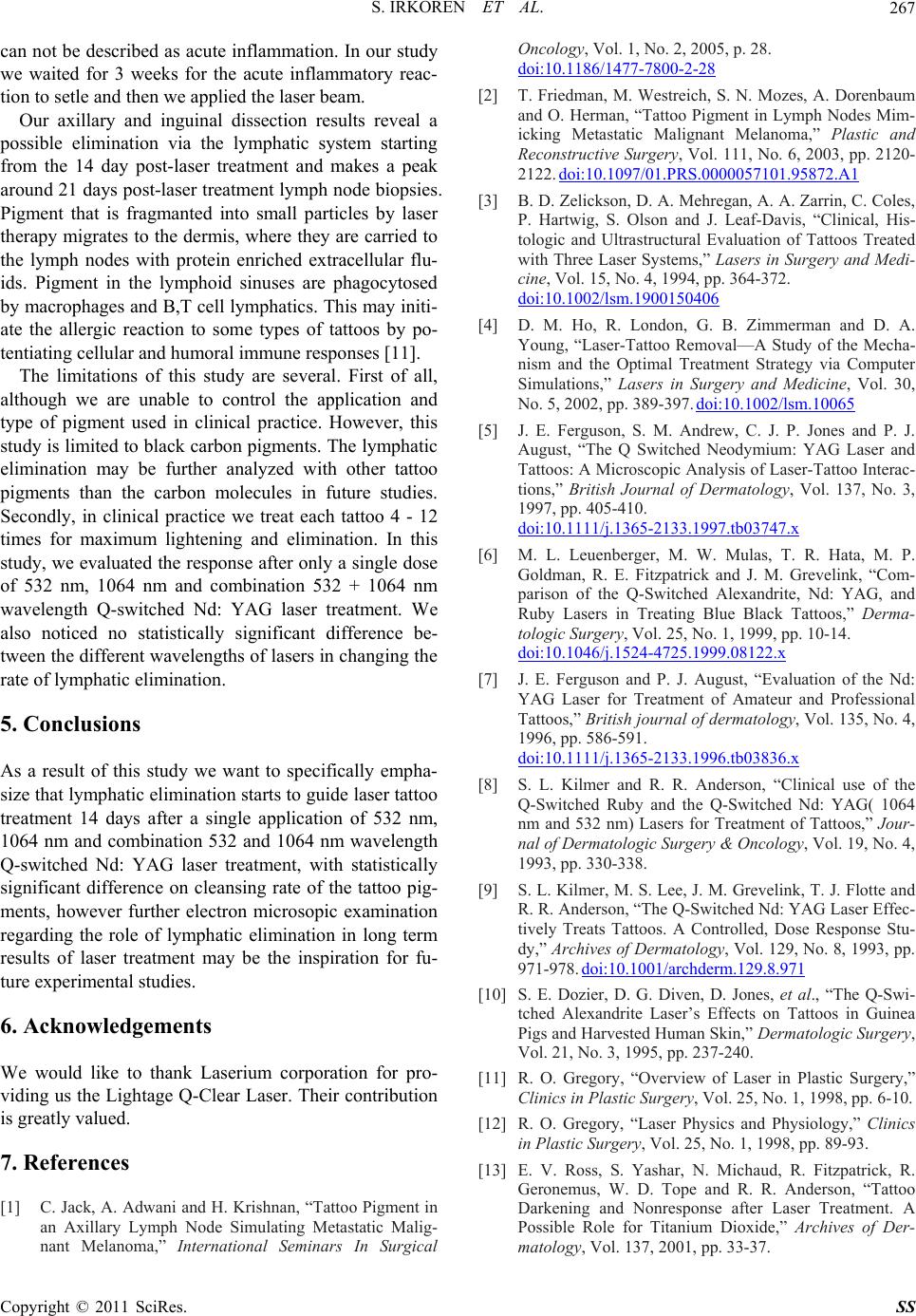
S. IRKOREN ET AL.267
can not be described as acute inflammation. In our study
we waited for 3 weeks for the acute inflammatory reac-
tion to setle and then we applied the laser beam.
Our axillary and inguinal dissection results reveal a
possible elimination via the lymphatic system starting
from the 14 day post-laser treatment and makes a peak
around 21 days post-laser treatment lymph node biopsies.
Pigment that is fragmanted into small particles by laser
therapy migrates to the dermis, where they are carried to
the lymph nodes with protein enriched extracellular flu-
ids. Pigment in the lymphoid sinuses are phagocytosed
by macrophages and B,T cell lymphatics. This may initi-
ate the allergic reaction to some types of tattoos by po-
tentiating cellular and humoral immune responses [11].
The limitations of this study are several. First of all,
although we are unable to control the application and
type of pigment used in clinical practice. However, this
study is limited to black carbon pigments. The lymphatic
elimination may be further analyzed with other tattoo
pigments than the carbon molecules in future studies.
Secondly, in clinical practice we treat each tattoo 4 - 12
times for maximum lightening and elimination. In this
study, we evaluated the response after only a single dose
of 532 nm, 1064 nm and combination 532 + 1064 nm
wavelength Q-switched Nd: YAG laser treatment. We
also noticed no statistically significant difference be-
tween the different wavelengths of lasers in changing the
rate of lymphatic elimination.
5. Conclusions
As a result of this study we want to specifically empha-
size that lymphatic elimination starts to guide laser tattoo
treatment 14 days after a single application of 532 nm,
1064 nm and combination 532 and 1064 nm wavelength
Q-switched Nd: YAG laser treatment, with statistically
significant difference on cleansing rate of the tattoo pig-
ments, however further electron microsopic examination
regarding the role of lymphatic elimination in long term
results of laser treatment may be the inspiration for fu-
ture experimental studies.
6. Acknowledgements
We would like to thank Laserium corporation for pro-
viding us the Lightage Q-Clear Laser. Th eir contribution
is greatly valued.
7. References
[1] C. Jack, A. Adwani and H. Krishnan, “Tattoo Pigment in
an Axillary Lymph Node Simulating Metastatic Malig-
nant Melanoma,” International Seminars In Surgical
Oncology, Vol. 1, No. 2, 2005, p. 28.
doi:10.1186/1477-7800-2-28
[2] T. Friedman, M. Westreich, S. N. Mozes, A. Dorenbaum
and O. Herman, “Tattoo Pigment in Lymph Nodes Mim-
icking Metastatic Malignant Melanoma,” Plastic and
Reconstructive Surgery, Vol. 111, No. 6, 2003, pp. 2120-
2122. doi:10.1097/01.PRS.0000057101.95872.A1
[3] B. D. Zelickson, D. A. Mehregan, A. A. Zarrin, C. Coles,
P. Hartwig, S. Olson and J. Leaf-Davis, “Clinical, His-
tologic and Ultrastructural Evaluation of Tattoos Treated
with Three Laser Systems,” Lasers in Surgery and Medi-
cine, Vol. 15, No. 4, 1994, pp. 364-372.
doi:10.1002/lsm.1900150406
[4] D. M. Ho, R. London, G. B. Zimmerman and D. A.
Young, “Laser-Tattoo Removal—A Study of the Mecha-
nism and the Optimal Treatment Strategy via Computer
Simulations,” Lasers in Surgery and Medicine, Vol. 30,
No. 5, 2002, pp. 389-397. doi:10.1002/lsm.10065
[5] J. E. Ferguson, S. M. Andrew, C. J. P. Jones and P. J.
August, “The Q Switched Neodymium: YAG Laser and
Tattoos: A Microscopic Analysis of Laser-Tattoo Interac-
tions,” British Journal of Dermatology, Vol. 137, No. 3,
1997, pp. 405-410.
doi:10.1111/j.1365-2133.1997.tb03747.x
[6] M. L. Leuenberger, M. W. Mulas, T. R. Hata, M. P.
Goldman, R. E. Fitzpatrick and J. M. Grevelink, “Com-
parison of the Q-Switched Alexandrite, Nd: YAG, and
Ruby Lasers in Treating Blue Black Tattoos,” Derma-
tologic Surgery, Vol. 25, No. 1, 1999, pp. 10-14.
doi:10.1046/j.1524-4725.1999.08122.x
[7] J. E. Ferguson and P. J. August, “Evaluation of the Nd:
YAG Laser for Treatment of Amateur and Professional
Tattoos,” British journal of dermatology, Vol. 135, No. 4,
1996, pp. 586-591.
doi:10.1111/j.1365-2133.1996.tb03836.x
[8] S. L. Kilmer and R. R. Anderson, “Clinical use of the
Q-Switched Ruby and the Q-Switched Nd: YAG( 1064
nm and 532 nm) Lasers for Treatment of Tattoos,” Jour-
nal of Dermatologic Surgery & Oncology, Vol. 19, No. 4,
1993, pp. 330-338.
[9] S. L. Kilmer, M. S. Lee, J. M. Grevelink, T. J. Flotte and
R. R. Anderson, “The Q-Switched Nd: YAG Laser Effec-
tively Treats Tattoos. A Controlled, Dose Response Stu-
dy,” Archives of Dermatology, Vol. 129, No. 8, 1993, pp.
971-978. doi:10.1001/archderm.129.8.971
[10] S. E. Dozier, D. G. Diven, D. Jones, et al., “The Q-Swi-
tched Alexandrite Laser’s Effects on Tattoos in Guinea
Pigs and Harvested Human Skin,” Dermatologic Surgery,
Vol. 21, No. 3, 1995, pp. 237-240.
[11] R. O. Gregory, “Overview of Laser in Plastic Surgery,”
Clinics in Plastic Surgery, Vol. 25, No. 1, 1998, pp. 6-10.
[12] R. O. Gregory, “Laser Physics and Physiology,” Clinics
in Plastic Surgery, Vol. 25, No. 1, 1998, pp. 89-93.
[13] E. V. Ross, S. Yashar, N. Michaud, R. Fitzpatrick, R.
Geronemus, W. D. Tope and R. R. Anderson, “Tattoo
Darkening and Nonresponse after Laser Treatment. A
Possible Role for Titanium Dioxide,” Archives of Der-
matology, Vol. 137, 2001, pp. 33-37.
Copyright © 2011 SciRes. SS